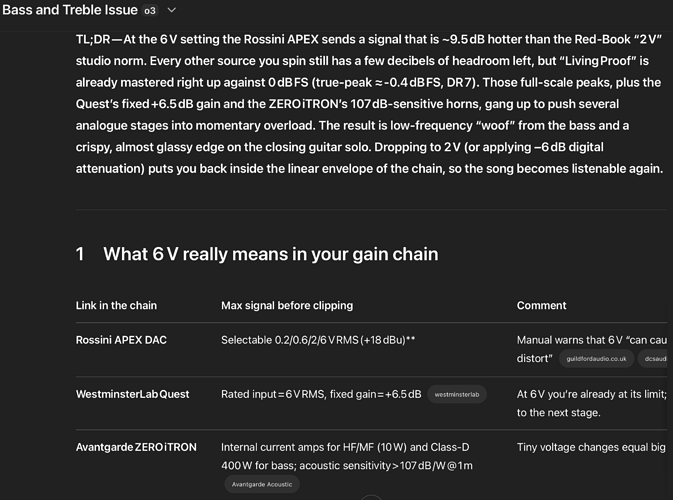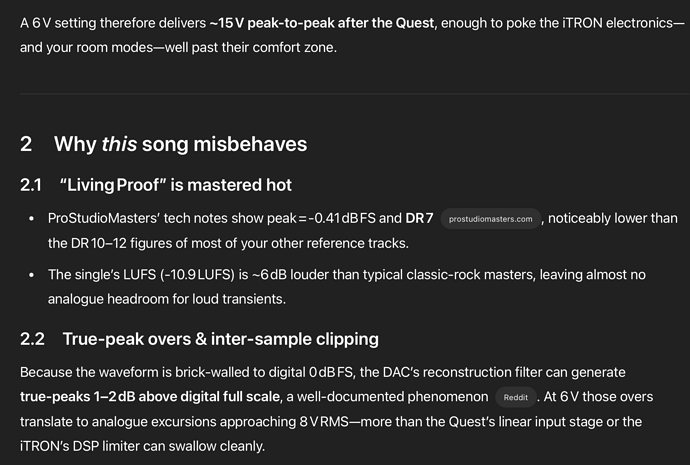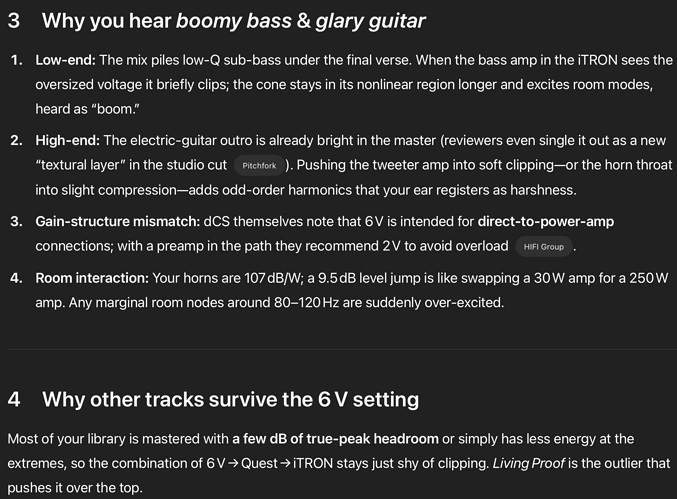2V did the trick with “Living Proof” by The War on Drugs. It’s still a bit boomy at the end but the guitar sounds nice now. It’s the first track that I encountered where 2V sounds better than 6V. It would be interesting to know if the Vivaldi was playing at 2V or 6V when Chris Connaker listened to that song in the third Quintessence room at Apoxona.
Em says they were running at 6V (we have experience with the Relentless pre from several Varèse events and know it is perfectly happy with 6V in).
I am sure that @AndrewS is correct that the D’Agostino Relentless has no issues with a 6V input. However you have a very different system and I would suspect that what your ears are telling you is correct.
The manufacturer’s specifications for your Westminster Quest preamp show that a 6V input provides a 12V output. Input sensitivity is the voltage that provides the maximum output before clipping. Playing a modern pop track which may be subject to the loudness war suggests that 0dBfs may be approached constantly ( i.e 6V output and 12V into your active speakers). You have a pair of active speakers of unusual sensitivity ( 107dB is Avantgarde’s specification). Although Avantgarde do not provide an input sensitivity figure I speculate that a 12V input may drive the active speaker into clipping. This is . of course, avoided by attenuating the output of the preamp by use of the volume control. However you may be using a range of the volume control outside of that envisaged by the designers, especially as you listen at lower volumes.
So reducing the output of your Bartok first to a more reasonable ( in the circumstances) 2V makes sense. BTW 2V has a historical reason for being seen as a a"typical" output voltage as this voltage is the redbook standard for CD players.
I agree with you for the most part, Pete, but I still think it is worth experimenting in each case. For instance running at 6V out but with 9.5dB of attenuation in the DAC would give the same output voltage as 2V/0dB but just might (for instance) use a different gain structure in the output stage which, if true, might explain why some think it sounds better. I for one hear much more ”life”, dynamics and colour on 6V, as long of course as one is not over-driving something future down the chain.
Here is the explanation that o3, the latest OpenAI reasoning model with web search capabilities, gave. It provides in-text references to the sources it used. I know now, that if a track is mastered hot, I have to use 2V. Fortunately, it’s the first track/album I came across where this is an “issue.”
The measurements of the Lina in Hi Fi new’s review may give some insight why the 2V setting could sound better than the 6V setting. If one is below -10dB at 6V, the 2V setting may offer an extra 2dB dynamic range playing at the equivalent loudness -1 to 0dB. Can we hear it? Perhaps, I seem to prefer riding the top of volume range at 2v rather than 10 dB lower on the 6V setting. But ultimately is clearly very system dependant
I have to admit, “Private Investigations” on the Money For Nothing (2022 Remaster) album is also unlistenable after 3:00 at 6V and sounds much better at 2V.
It’s system dependent but also recording/mastering dependent. Try “Private Investigations” on The Best Of Dire Straits & Mark Knopfler - Private Investigations and the Money For Nothing (2022 Remaster) albums at 2V and 6V. On my system, the same song sounds much better at 6V on the former album and is unlistenable at 6V on the latter.
I much prefer to listened to the 16bit/44.1kHz version of “Private Investigations” at 6V than to the 24bit/192kHz version at 2V. At 2V the latter version lacks DR and sounds sterile, whereas the former at 6V has a much more lively guitar sound that penetrates the whole body. 2V sucks the life out of my system. I would have never gotten into Blues and Jazz with 2V.



